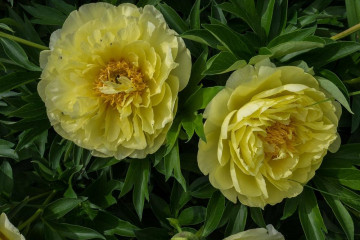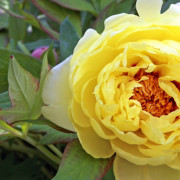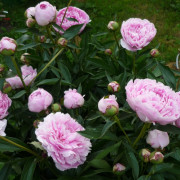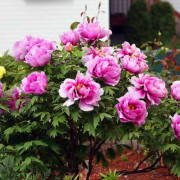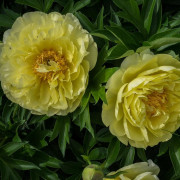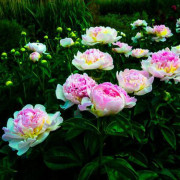Peony Red Charm (Paeonia Red Charm) - characteristics of the variety
Content:
Peony Red Charm is considered a favorite of flower growers. It is one of the most popular varieties and has been ubiquitously grown in garden plots for several decades.
Peony Red Charm (Paeonia Red Charm) - what kind of variety, history of creation
Peony Red Charm was introduced in the USA in 1944. The name literally translates from English as "red charm". For a long time, the flower has been actively cultivated in China, where it is considered a symbol of prosperity and happiness.
Brief description, characteristic
Botanical description of the peony:
- The form of life is a herbaceous milky-flowered perennial.
- The stems are strong, thick, but the inflorescences are too heavy, so the plant needs support.
- The leaves are openwork, over time they change color from a light green to a dark shade, retain their attractiveness until the very cold, turn purple by autumn.
- The aroma is light.
- The petals are regular, concave, dark red.
- The flower is lush, there are many petals in it; when opened, its diameter is about 20 cm.
- The height of the bush is about 80 cm.
Advantages and disadvantages of the variety
Pluses of peony Red Charm:
- high decorativeness;
- suitable for cutting, decorating bouquets;
- subtle, delicate aroma;
- ideal for use in landscaping.
There is only one minus - low immunity to fungal diseases and pests.
Use in landscape design
This herbaceous variety is most often used to decorate gazebos, paths, as a curb plant. Peony Charm also looks great in flower beds, in combination with other plants. Best of all, it is in harmony with colors such as:
- irises;
- geranium;
- poppies;
- digitalis.
Growing a flower, how to plant it in open ground
The best way to plant and propagate the Red Sharm peony is to split the root system. Plants aged 4-5 years are optimal for this procedure.
Planting by root cuttings
A root cut is a part of the rhizome of a peony that has an independent root and 1 or more eyes for growth. To apply this planting method, you must first select the planting material. Its preparation is carried out as follows:
- Carefully, without damaging the roots, the rhizome of an adult peony is dug out. It is divided into small pieces, each about 6 cm in size. All pieces must have at least 1 bud and root.
- For a couple of hours, parts of the rhizome are placed in a solution of potassium permanganate, then rolled in crushed charcoal and dried in the fresh air until a small crust forms (this will take 10-12 hours, you can leave it overnight).
After that, the planting material is deepened into the nutrient mixture by about 4 cm.The place where the cuttings will sprout should be well lit. The substrate must be regularly moistened.
What time is the boarding
The optimal planting time is late August - early September.
Location selection
The place should be well lit, protected from gusts of cold winds and drafts. Light shading is acceptable, which protects the flower from the midday hot rays. The soil needs nutritious and well-drained soil. Groundwater should pass no higher than 1 m from the plant.
How to prepare the soil and flower for planting
The planting pit is prepared approximately 1 month before planting. The soil should be well loosened, with the obligatory addition of compost and humus, as well as mineral and complex fertilizers. A couple of hours before the direct planting in the ground, the root system of the cuttings is checked for damage and soaked in a solution of potassium permanganate, the cuts are processed with crushed charcoal.
Planting procedure step by step:
- Drainage and necessary fertilizers are introduced into the prepared planting pit.
- Sand is added to too clayey soil and vice versa.
- Prepared seedlings are placed in holes, sprinkled with earth.
After that, the soil is thoroughly watered and mulched with any natural material.
Planting with seeds (for breeding)
Planting with seeds for hybrid varieties is not applicable. Peonies can grow from seeds, but these will already be plants of a different variety, and not Red Charm.
Plant care
The peony care scheme is not too complicated, but all basic procedures must be carried out on time, as well as monitor the appearance of possible fungal infections and parasitic insects.
Watering and feeding
In the first 2 years after planting, feeding the plant is not required; those nutrients that were laid in the ground during planting will be enough. Starting from the 3rd year, flowers are fed:
- immediately after the snow has completely melted (approximately in mid-April);
- during the formation of buds;
- at the end of flowering.
For feeding, special complex fertilizers are used. During flowering, potassium-phosphorus fertilizers can be applied, as well as a weak solution of chicken manure. In the spring, a little ash is introduced into the soil.
Mulching and loosening
Each time after watering, the soil is carefully loosened so as not to hurt the root system of the flower. You can replace this procedure with mulching.
Preventive treatment
Most often it is carried out in early spring, even before the buds are laid. The peony is treated with fungicidal solutions. Bordeaux mixture will protect from pests (3 liters per 1 bush). Since this variety has a rather low immunity, a similar treatment should be carried out after the flowering of the plant. You also need to carefully follow all the rules for the care and planting of a flower, the health of the plant will depend on this.
Peony Blossom Red Charm
The flowering is lush and long lasting. If you properly care for a peony, you can extend its life.
A period of activity and rest
Flowering begins in late May - early June, lasts about a crescent. After that, the bush goes into a dormant stage.
Care during and after flowering
During flowering, it is necessary to regularly water and feed Red Charm. It is important to exclude the use of nitrogenous fertilizers, they are contraindicated in flowers.
What to do if it does not bloom, possible reasons
The main reasons that can cause a lack of flowering are the following:
- Lack of light. If the bush was originally planted incorrectly, it must be transplanted to a more open place. Only then will it bloom.
- Lack of nutrients. After 2 years of life, additional fertilization is required to the substrate.
- Very deep planting of the flower. The maximum depth of the planting pit should be 50 cm.
Peonies after flowering
Once the plant has faded, it needs to be prepared for winter. This should be taken into account especially carefully. The development and flowering of a peony next year depends on the correct observance of all the rules.
Transfer
Transplanting a peony is not recommended, since the root system grows, becomes very powerful, and should not be disturbed. But if it became clear that the seat was chosen incorrectly, you can carefully transplant Red Charm using the transshipment method.
Pruning
It is very important to remove all wilted flowers, they can cause the development of many infectious diseases. Cardinal pruning of herbaceous peonies is carried out before wintering - the ground part is completely removed, only small parts of the stem of 15 cm remain.
Preparing for winter
The variety can hibernate at fairly low temperatures, so preparing for winter is not difficult. The remaining stems are spud up to the maximum possible height. From above, they are covered with cut parts of an adult plant.
Diseases, pests and ways to control them
Of the diseases, this variety is especially unstable to gray rot, powdery mildew, mosaic, and rust. Preventive treatments and fungicides help to cope with them. The most common flower pests are aphids, ants, nematodes. To combat them, special insecticides are used.
Peony Red Charm is the most beautiful variety, early flowering, bright and lush. The culture does not require any special activities during cultivation, and is also universal in terms of use in landscape design, so even beginners can handle plant care.








